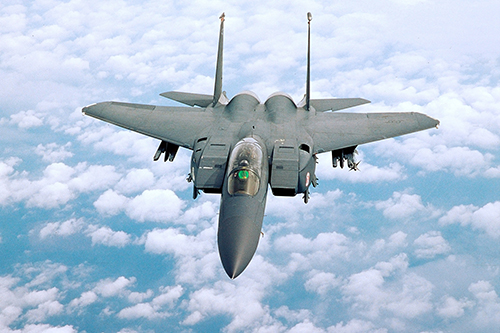The McDonnell Douglas F-15 Eagle, a stalwart of American air power, represents a high point in fighter aircraft design and performance. Known for its formidable capabilities and exceptional engineering, the F-15 has earned its place as one of the most effective and respected multirole fighters in the world. This article delves into the F-15’s outstanding features, including its powerful engines, impressive speed, and high-altitude performance, highlighting why it remains a key asset in the U.S. Air Force and beyond.
Engine Power and Speed
At the heart of the F-15 Eagle’s impressive performance are its twin Pratt & Whitney F100-PW-100 or PW-200 jet engines. These engines are integral to the aircraft’s remarkable speed and agility. Each engine produces substantial thrust, enabling the F-15 to reach a maximum speed of 2,665 kilometers per hour (approximately 1,655 miles per hour). This incredible speed allows the F-15 to quickly engage or evade threats, making it a formidable opponent in aerial combat.
The F-15’s engines are not only powerful but also engineered for reliability and performance at various operational conditions. The combination of high thrust and advanced aerodynamics ensures that the F-15 can achieve and sustain high speeds while maintaining stability and control. This capability is crucial for a multirole fighter tasked with both air superiority and ground attack missions.
High-Speed Flight and Takeoff Weight
One of the F-15’s most impressive attributes is its ability to fly at high speeds while carrying a substantial takeoff weight. With a maximum takeoff weight of up to 30 tons, the F-15 demonstrates a remarkable capacity for both speed and load-bearing. The aircraft can reach speeds of 254 meters per second (approximately 835 feet per second), allowing it to perform rapid intercepts and high-speed maneuvers.
This high-speed capability, combined with its ability to operate effectively at various weights, enhances the F-15’s versatility in combat scenarios. Whether engaging in dogfights or executing precision strikes, the F-15’s performance ensures that it can adapt to different mission requirements and operational environments.

Design and Aerodynamics
The F-15 Eagle’s design and aerodynamics contribute significantly to its superior performance. The aircraft features a sleek, streamlined fuselage that minimizes drag and maximizes aerodynamic efficiency. Its large, forward-swept wings provide exceptional lift and maneuverability, allowing the F-15 to perform agile aerial maneuvers and maintain high speeds.
The F-15’s design also includes advanced avionics and control systems that enhance its combat capabilities. The aircraft is equipped with a sophisticated radar system capable of tracking multiple targets, as well as electronic countermeasures that protect it from enemy threats. These systems ensure that the F-15 remains effective in a variety of combat scenarios, from air-to-air engagements to ground attack missions.
Operational History and Legacy
Since its introduction in the 1970s, the F-15 Eagle has established a distinguished record of service and combat success. The aircraft has been a key component of the U.S. Air Force’s air superiority strategy, and its capabilities have been demonstrated in numerous conflicts and exercises. The F-15 has achieved an impressive combat record, with a high number of air-to-air victories and a reputation for reliability and effectiveness.
The F-15’s legacy extends beyond its initial service with the U.S. Air Force. The aircraft has been adopted by several allied nations, further cementing its status as a premier fighter jet. International operators have benefited from the F-15’s advanced technology and performance, integrating it into their own air forces and contributing to global air power.
Future Prospects
The F-15 Eagle continues to evolve with ongoing upgrades and enhancements. Modern variants, such as the F-15EX, incorporate advanced avionics, improved engines, and new weapon systems, ensuring that the F-15 remains at the forefront of air combat technology. These upgrades enhance the aircraft’s capabilities and extend its service life, keeping it relevant in the face of emerging threats.
Conclusion
The McDonnell Douglas F-15 Eagle stands as a testament to engineering excellence and air combat prowess. With its powerful Pratt & Whitney F100-PW-100 or PW-200 engines, impressive speed, and ability to operate effectively at high speeds and substantial takeoff weights, the F-15 remains a formidable fighter jet. Its legacy of success and ongoing evolution underscore its importance in modern air warfare, ensuring that the F-15 Eagle will continue to soar high as a symbol of air superiority and technological innovation.





